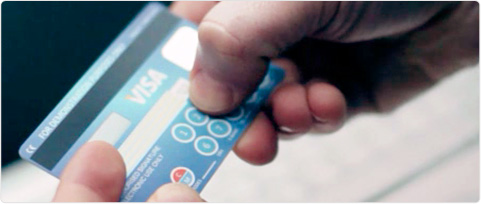6 Things You Won’t Hear from an Online Entrepreneur
When you think about selling on the Internet – it’s not always an obvious matter of do’s and don’ts.
When you think about selling on the Internet – it’s not always an obvious matter of do’s and don’ts.
 If you are a merchant, you definitely care about the security of your online transactions. One of the ways to achieve that is implementing 3-D Secure. The name probably rings a bell but if not, let us give you a short summary of what it is, together with the advantages and disadvantages that come with it.
If you are a merchant, you definitely care about the security of your online transactions. One of the ways to achieve that is implementing 3-D Secure. The name probably rings a bell but if not, let us give you a short summary of what it is, together with the advantages and disadvantages that come with it.
3-D Secure system is a set of security standards developed by Visa, but implemented also by other card organizations. The Visa system is called Verified by Visa and the MasterCard system is offered as MasterCard SecureCode. In a nutshell, if 3-D Secure is implemented then straight after entering customer’s card information, he or she is asked to enter a password which helps the card issuer to identify the card holder.
 It’s a busy time at PayLane – we’ve just been audited. No, not by the IRS. Our taxes are just fine. Then what does it mean? Last week we were visited by a QSA (Qualified Security Assessor) from an external audit company who, in short, decides whether a financial company is trustworthy or not. He spent a week with us, going through hundreds of document pages, checking our network’s and servers’ safety and interviewing the staff.
It’s a busy time at PayLane – we’ve just been audited. No, not by the IRS. Our taxes are just fine. Then what does it mean? Last week we were visited by a QSA (Qualified Security Assessor) from an external audit company who, in short, decides whether a financial company is trustworthy or not. He spent a week with us, going through hundreds of document pages, checking our network’s and servers’ safety and interviewing the staff.
 Scam and scammers are something that we need to fight with almost each day. Unfortunately it’s one of the worst plagues of our industry. How many times did you receive an e-mail with a request to change the password in some kind of e-wallet service (such as PayPal)? How many times were you asked to do something in your bank account? To have it done you just needed to click on some link in the email and put your login and password in a login form. Simple. But fake.
Scam and scammers are something that we need to fight with almost each day. Unfortunately it’s one of the worst plagues of our industry. How many times did you receive an e-mail with a request to change the password in some kind of e-wallet service (such as PayPal)? How many times were you asked to do something in your bank account? To have it done you just needed to click on some link in the email and put your login and password in a login form. Simple. But fake.
Those websites look similar to the original ones. But they are not. Once you put your login and password – these credentials will be stored in scammer’s database.
 We all know that high security is a must for every business. One of the ways to ensure the safety of your clients’ money is implementing 3-D Secure. But what does it mean from the technical side?
We all know that high security is a must for every business. One of the ways to ensure the safety of your clients’ money is implementing 3-D Secure. But what does it mean from the technical side?
Thanks to PayLane’s implementation of the 3-D Secure technology, it is not merchants, but banks that are responsible for chargebacks in case of fraud transactions, on condition that:
To make it easier for merchants to use 3-D Secure, without requiring them to have in-depth knowledge of the whole authentication process, we have brought it down to 2 functions called through API.
 Remember us saying that we like to do more than just processing payments? We want to help all the really great businesses out there and that’s why we want to promote them.
Remember us saying that we like to do more than just processing payments? We want to help all the really great businesses out there and that’s why we want to promote them.
So here’s out latest perk for merchants – the PayLane Verified Merchant seal.
The short answer is: you will improve your business and sell more.
The just a little bit detailed answer is: …
 Whenever we’re explaining one-click payments to our partners or clients, it’s always good to add the “just like Amazon or Apple” phrase. In most cases it says more than any detailed description would and there’s always the “big brand effect”. Of course one of the greatest advantages of one-click payments is that this solution is fast and convenient. That’s why when making a purchase, I was a bit surprised that Apple asked me to provide additional specific documents in order to prove my identity. But, as I wrote recently, confirming my identity is completely understandable in some cases. What struck me was the way it was handled.
Whenever we’re explaining one-click payments to our partners or clients, it’s always good to add the “just like Amazon or Apple” phrase. In most cases it says more than any detailed description would and there’s always the “big brand effect”. Of course one of the greatest advantages of one-click payments is that this solution is fast and convenient. That’s why when making a purchase, I was a bit surprised that Apple asked me to provide additional specific documents in order to prove my identity. But, as I wrote recently, confirming my identity is completely understandable in some cases. What struck me was the way it was handled.
Before I tell the story, I have to clearly state that this was a local Apple department (not the US Apple), but after some googling it looked like the same department contacts also, for example, UK customers. We also do not intend to mock or criticize Apple – we just want to present an interesting case study and an example that even really big brands either make mistakes or sometimes do not fully control their representatives.
 CVV codes described in the previous part aren’t the only way to make your transactions secure. There are forms of security, which are based on the payer’s localization. However, you may also come across simpler solutions, where only entered data is verified.
CVV codes described in the previous part aren’t the only way to make your transactions secure. There are forms of security, which are based on the payer’s localization. However, you may also come across simpler solutions, where only entered data is verified.
An example of that could be AVS – its mechanism compares your address info given in the shopping order with details of the card holder. Depending on the degree and type of eventual errors, AVS returns an appropriate error code, which are the base of estimating the probability of a fraud. Contrary to appearances, it is not inconvenient to clients – the system can tell the difference between a real scam and a situation when a buyer made a spelling mistake.

Visa Europe offers a credit card that comes with its own 48×8 pixel LCD panel on the back. That would be located just above the signature of the cardholder. The solution, called CodeSure Matrix Display Card, has been invented to increase security of credit cards, which can be used e.g. in online shopping.
 CVV2, CVC2, or just the card security code (CSC), are different names for the security features for credit and debit card transactions. CVV2 provides increased protection against credit card fraud.
CVV2, CVC2, or just the card security code (CSC), are different names for the security features for credit and debit card transactions. CVV2 provides increased protection against credit card fraud.
Imagine that you’re buying something over the Internet, fax, mail or phone. Since you’re not present in person, such transactions are called “card not present transactions”. Normally, you give your card to a merchant. You take it out of your wallet, you can present your signature or prove that you know the PIN. Somehow you prove this card belongs to you. Everything goes well…